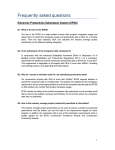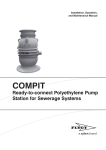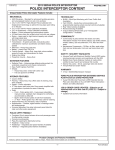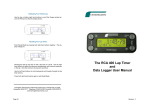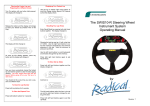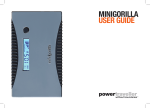Download User Guide and Instruction Manual
Transcript
User Guide and Instruction Manual Elstead Lighting Limited Elstead House, Mill Lane, Alton, Hampshire GU34 2QJ Telephone: +44 (0)1420-82377 Fax: +44 (0)1420-89261 Email: [email protected] Website: www.elstead-lighting.co.uk IMPORTANT Please read the product installer warnings on page 2 before any power is turned on. Garden Zone product warning notes Damage can occur to products as soon as they are switched on unless certain precautions are taken. All fittings must be plugged into the cable sets before the power is applied. Fittings must not be connected whilst the power is on. The light emitting diodes (LED’s) in the light fittings and the electronic drivers (transformers) for the 12 volt plug and go fittings can be damaged at switch on if this procedure is not followed. The amount of power used by the LED’s and the drivers must be controlled within certain limits. A. Electronic Drivers (transformers) for the 12 volt system 1. There are two drivers (electronic transformers) in the GZ range, an 11 Watt model and a 28 Watt model. 2. The 11 watt model should have a minimum of 3 watts and maximum of 9 watts of loading. 3. The 28 watt model should have a minimum of 9 watts and maximum of 25 watts of loading. 4. It is essential these wattage limits are complied with, under or overloading will damage the light fittings and the drivers. B. The 12 volt Plug and Go fittings with LED’s 1. All fittings use LED’s to produce the light output. 2. The LED cluster on a fitting has a stated power consumption, this is given in watts. This figure is shown in the GZ brochure and on the packaging of the fitting. C. Coupling the drivers and the light fittings 1. Decide which fittings are required for the garden lighting layout. 2. Write down the power consumed (in watts) for each fitting, record the total wattage. 3. Decide how many drivers are required to power the selected fittings. 4. Ensure each driver has a wattage loading between the stated minimum and maximum wattage limits shown in ‘A’ above. 5. DO NOT USE A DRIVER BELOW ITS MINIMUM WATTAGE LIMIT OR ABOVE THE MAXIMUM WATTAGE LIMIT. By following the above details, the fittings can be installed as required and will not be damaged. Read the details in the Garden Zone user guide and proceed carefully with the design and installation of the Garden Zone product range. Cable layout detail for the 12 volt system Cable runs should not pose any hazard to adults, children or domestic animals that normally have access to the project area. The electrician that you consult will advise on the position of cable runs. Cables should be extended and not coiled Each 12V fitting has a cable, either 1.5 or 2.5 metres long. Take this length into account when assessing the system layout. Trip hazards must be avoided, try and run cables away from paths, footways and access routes. Where it is possible the 12V cables can be chosen to be buried or covered. However buried cables will be susceptible to damage by garden tools and machinery. Installing 12 volt fittings. 1. Carry out a trial fitting of all 12V units, in the planned positions. The layout of the 12V cables should be part of the trial. 2. Lay out the cables on the surface during the trial. 3. Check the cable run to each proposed light fitting position. Consider the detail in the section above for 12V cables. 4. Prepare the mounting for the 12V fitting in the design plan location. 5. Attach or push in the fitting onto the mounting surface. 6. Connect the fitting cable to the cable set outlet plug. 7. Ensure the plug connections are fully assembled and hand tight for all light fittings. 8. Ensure all staff are clear of the lighting area and test the installation. After test remove the power and carry out any finishing or tidying work. 9. Secure cables and where it is necessary bury or cover cable runs. 10. Set the controls for switching and timing at the distribution point or elsewhere. 11. The installation is now complete. Setting up the distribution point for the 12 volt system The distribution point for the 12V set up must be fed with a 240V supply. All drivers for LED fittings are connected to the mains supply. The distribution point should be set within a control box having a water protection rating of IP65 or better. All cable feeds from the box should also be protected to IP65. The garden design plan should enable accurate distances to be determined for the 12V cable runs and the position of output plugs. Seek advice from your electrician about the cable runs. Connecting cables to drivers, further plug sets and fittings. All 12V cabling is connected to drivers and additional cable sets by special connectors. The cable sets allow connection to be made that are rated at IP65 when properly attached. All connections have to be made to ensure there is continuity of the 12V circuit. Example. A 6 metre plug set with five connections is to be used. This is connected to an 11W driver. The driver output must be between the minimum of 3 watts and a maximum of 9 watts. This plug set has five outlets. It is supplied with four blanking continuity plugs and one outlet position open. A single Beta 12 fitting (LED output 3 watts) is connected to the open outlet. This arrangement will satisfy the correct set up conditions. The plug set has four further connection points available for fittings. The maximum remaining output for the driver is 6 watts. It is important that all 12V plug connections are assembled correctly. The 12V lighting system will not operate if connections are loose or cable outlets do not have eithera blanking plug or a light fitting cable attached. The blanking plugs and light fitting cable plugs maintain the continuity of the circuit. Preparing the 12 volt fittings for installation The method of mounting a fitting will vary with the type and the attitude required of the fitting. All fittings must be secured correctly and permanently (except spike versions) on the chosen surface. The fittings should be attached by screws or bolts to hard surfaces and with spikes and poles for soft surfaces such as soil or turf. There are a variety of mounting methods used through the range. Inspect the fitting and decide how it will be attached to the surface in the chosen location. Decide where the 12V fitting cable will be run to the cable set outlet point. Garden Zone exterior lighting range, planning and guidance notes The Garden Zone range of landscape and garden lighting allows gardens, specimen plants, pathways and decked areas to be illuminated and focussed upon. The range of over eighty fittings and components offers a huge variety of schemes and lighting layouts within gardens and landscapes. All light fittings in the range are manufactured in compliance with British and European standards and may be incorporated safely into any suitable lighting system. These notes give customers a clear understanding of the scope of the product range, how the fittings can be installed and an indication of the electrical safety detail required for exterior lighting. The notes offer guidance on electrical work, but in all cases Elstead Lighting Ltd recommend that customers discuss in detail their lighting schemes with competent and qualified electricians and / or our approved Garden Zone advisors. Within the UK, electrical installation work is controlled by the Building Regulations and installations generally require approval and certification. This can only be achieved through local authorities and approved electrical contractors. The Garden Zone range of exterior fittings will expand and develop over time, offering many more features and options. The use of lighting within gardens and landscapes gives customers an opportunity to design schemes that enhance the features and ambience obtained from the garden. With Garden Zone products the visual aspects of the garden can be enjoyed even after the sun has disappeared. Planning your lighting project. Look carefully at the garden or landscape area concerned and decide which plants, trees or features would benefit from lighting. Produce a detailed plan of the garden showing where lighting is desirable. Draw the plan to scale so that distances for cable runs and electrical supply can be calculated. For the project, electricity will need to be supplied at 240 volts and 12 Volts. The design should be considered in two sections; that fed by 240 volts and the part requiring 12 volts for Plug & Go use. The electrical supply for your project will initially come from the dwelling or an outhouse with mains electricity at 240V. The garden lighting layout should be assessed and a hub or distribution point for the lighting display chosen. From the distribution/hub outlets are taken to feed the fittings requiring 240V. Also taken from the hub is the supply to feed the Plug & Go 12V cable system and its driver(s). It is important that the hub site location is carefully chosen and enables all cabling to be fed as required to all the fittings. The products within the Garden Zone range can be viewed in the brochure. Assess the products and determine which light fittings are desirable for your project. Look at the mounting methods outlined for the fittings. These will determine the surfaces to which the fittings can be attached. All surfaces may be used, as Garden Zone has components for soil, turf and harder materials such as timber, concrete and brick. Electrical considerations. The electrician that is consulted will be able to advise on specific matters such as mains cable types, cable layout, cable protection, weather protection etc. The detail below outlines some electrical aspects that require consideration at the planning and costing stage. For all external electrical circuits there must be a method of controlling the period during which the fittings are lit. The lit periods can be controlled by timers or sensors. This regulation is in place to reduce consumption of electricity, prevent external circuits being left on continuously and to minimise the problem of light pollution to surrounding dwellings. The Garden Zone range has been designed to reduce the consumption of electricity by using very efficient LED’s and a low voltage supply, however the switching by sensors or timers will reduce any unnecessary consumption. Testing the 240 volt installation When all 240V fittings have been correctly installed and wired the installation is ready for testing. Remove all staff from the area and restore the power, check all fittings are illuminated and positioned as required. Remove power after the test. Carry out any adjustment and cable placement as required. Set the controls for switching and timing at the distribution point or elsewhere. The system is now ready for use. Preparation detail for 12 volt fittings and equipment A lighting circuit using Garden Zone 12V fittings will require LED drivers, a selection of 12V distribution cabling with connectors, light fittings with LED light output Plug & Go. There are two drivers in the range. 1. The 11W driver, with a minimum output of 3 watts and a maximum of 9 watts. 2. The 28W driver, with a minimum output of 9 watts and a maximum of 25 watts. The electrical cabling and circuits must be protected by devices in the system that react when there is disruption of the circuits. Disruption may be caused by electrical features such as voltage fluctuations or by mechanical faults such as disturbance of the cable runs by gardening tools, garden machinery or animals. There are 6 cable types in the range. 1. A 2 metre extension lead. 2. A 20 metre extension lead. 3. A 1.5 metre extension lead with a triple plug at one end for attaching up to three 12 volt fittings. 4. A 6 metre cable set with 5 connections at one metre centres for a maximum of 5 fittings. 5. A 10 metre cable set with 9 connections at one metre centres for a maximum of 9 fittings. 6. A 16 metre cable set with 15 connections at one metre centres for a maximum of 15 fittings. The mains cables require protection and must have resistance to the effects of flora and fauna, sunlight and chemicals. Care must be taken with cable runs so that risks to adults, children and domestic animals in the garden area are reduced. The 12V cable runs should arranged so that there is a minimum of surplus cable at the fitting and where possible the surplus should be arranged and restrained so that it does not pose a trip hazard. As a precaution, all lighting circuits should be switched off when garden tools and machinery is being used near the cable runs or circuits. Coiling of surplus cable should be avoided. Sizing the drivers to be used. The garden design plan will identify the areas of the garden to be lit. The catalogue can be used to identify the fittings that can be used and the output levels in watts for each fitting. See the example for the 28W driver in the introductory notes. The total load will be spread across a number of drivers. Each driver must have an output between the minimum and maximum wattage for that driver. Drivers should be used with output loads above the stated minimum and below the stated maximum for the driver. attached by screws or bolts. There are a variety of mounting methods used throughout the range. 2. Inspect the mounting plate or bracket and decide how the fitting will be attached. 3. Decide where the 240V intake will be run to the mounting of the fitting. 4. Inspect the sealing method set up on the fitting to ensure that moisture cannot enter the electrical connections. Ensure the sealing is restored and in place when the fitting is installed. Installing the 240 volt fittings Carry out a trial fitting of all 240V units, in the planned positions. Check the proposed cable run to each light fitting position. The electrician that you consult will advise on types of cable and the position of cable runs. The cable runs should not pose any hazard to adults, children or domestic animals that normally have access to the project area. Trip hazards must be avoided, try and run cables away from paths, footways and access routes. Wiring for 240 volt fittings 1. The fittings in the range have similar set ups and all use a terminal block that is mounted in the rear or the base of the fitting. 2. The connections from the light fitting are already made to the terminal block. 3. Feed the supply cable through the mounting surface and the sealing grommet on the fitting. 4. Attach the support bracket or plate on the mounting surface. 5. Connect the Brown or Red wire (Live) to the terminal already carrying a Red or Brown wire. 6. Connect the Blue or Black wire (Neutral) to the terminal already carrying a Blue wire. 7. Connect the Earth to the Yellow/Green terminal. If the earth wire is of the bare copper type, cover it with the piece of earth sleeve supplied. 8. Inspect the connections and ensure that all wire insulation touches the face of the terminal block and that there are no loose strands of wire exposed. 9. Carefully push all wiring into the void at the base or the rear of the fitting. 10. Attach the light fitting to the mounting plate or bracket 11. Continue with the wiring of all 240V fittings that are being installed. For 240V set ups, cabling can be cut to ideal lengths. For the Plug & Go 12V systems, cable lengths should be selected to suit the distances to be covered. The plug and go cables with plug outlets are 1.5m, 6m, 10m & 16 m long. There are also two extension leads which are used to extend the distance from the distribution point. The equipment installed at the distribution point should be able to house and protect the drivers for the 12V Plug & Go system. All of the 240V fittings are Class I types and have an earth terminal. All of the products when installed must be connected to the earth conductor of the lighting circuit. Attaching 240V fittings to a mounting surface All products should be permanently fixed to the selected mounting surface. It is safer to fix and then move the site if required rather than use a temporary fixing. The mounting surface will determine the actual method of fixing. Most hard surfaces use screw fasteners, softer surfaces use spikes and elevating tubes. Assess the mounting surface and determine how the supply cable will be laid up to the fitting. The intake to the fitting should be studied and provision made for the cabling to enter the fitting using the most convenient approach, whilst avoiding sharp radii and the stressing of the cable. The cable entry should be sealed with a cable gland to IP65 or higher. Low voltage Plug and Go fittings. Over 80% of the fittings in the Garden Zone range are powered by 12V from transformers (drivers). The fittings are connected to cable runs by purpose made plug connectors. The fittings must be mounted securely on either hard surfaces or garden spikes, the cabling connections are then made. As with the 240V types, full planning must be carried out to ensure that cable runs and positions are assessed. The 12V cabling is fed from the 240V hub, connected to the transformers/drivers. The 12V cabling system cannot be cut and re-wired, the system is used in the supplied lengths only. IMPORTANT. The power continuity of the cable set is maintained by either plugs or fittings always being in every cable set socket. On the cable sets with plug and go outlets, the distance between outlets is one metre. On these outlet points there must be either a light fitting plug or a blanking plug (supplied with cable sets) in place. The cable set will only work if outputs are correctly blanked or are driving light fittings. The output load must be matched to the capacity of the transformer/driver. There are two 12V drivers in the range. The GZ 11 watt driver should be used with a minimum load of 3 watt and a maximum load of 9 watts. The GZ 28 watt driver should be used with a minimum load of 9 watts and a maximum load of 25 watts. The load for an individual fitting can be found in the Garden Zone brochure. • • • Example. Loading for the 28 watt driver. (max 25 watts) The design calls for 2 x Beta 11 types, 1 x Beta 4 type, 1 x Beta 5 type, The loading for these types are shown below. Type Beta 11 Beta 4 Beta 5 Load 9 watt 3 watt 3 watt No off 2 1 1 Total load 18 watt 3 watt 3 watt Total driver load = 24 watts. The above theoretical design calls for these fittings and the loading output will suit the 28 watt driver. However if the design is changed and further fittings are required an additional driver will be required. Any combination the 11 watt & 28 watt drivers may be used providing the minimum and maximum loads for each driver are adhered to. The details for installation of 240V or 12V fittings are fully covered in the instructions further on in this leaflet. Garden Zone, installing 240 volt & 12 volt systems These instructions are provided to ensure safe fitting of the Garden Zone units. Please read all of the detail before starting work. Retain the data for future reference. These instructions cover a range of products, most instructions are general, and apply across the range. Please refer to the notes concerning the planning and design of garden lighting set-ups before attempting any installation work. Safety information • Electrical installation work is controlled within the UK Building Regulations. Replacement of existing fittings is normally exempt, except in kitchens, bathrooms and outdoors. Please consult your local authority or an electrician to determine if the proposed work is covered by the regulations. • Electrical products must be installed correctly and safely, consult an electrician to determine the correct method of installation for these fittings. Before any work is started, disconnect the supply at the fuse board and ensure that other persons cannot restore the electrical supply without your knowledge. Take care when working at height, use an assistant for awkward installation tasks. Lamping. Most fittings use LED’s. Failed LED’s cannot be easily repaired or replaced on site. Call customer service on (01420) 82377 for details of returning to the factory for repair. Planning and layout of garden lighting. • Ensure all planning and design work has been completed before attempting to install any components. • Consult an electrician concerning your planned layout. Preparing the distribution point for 240 volt and 12 volt use. The project design will identify the 240V and the 12V fittings for installation. The equipment to be used at the distribution point should be discussed with the electrician. There should be a means of switching the lighting circuit, and controlling the time the lighting display is illuminated. The electrician will identify equipment that is suitable for controlling the lighting circuit. If 12V fittings are also to be used, the distribution point will need to be set up to take drivers (LED transformers) to power the Plug and Go fittings. The Garden Zone range has two drivers for LED use. Elstead Lighting recommend that the 240V supply and the LED drivers are housed in a control box with an IP65 rating. The box will protect the equipment from moisture, solid bodies, flora and fauna. See the details below for fitting either 240V or 12V equipment. Preparing the 240 volt fittings for installation WARNING: All 240V Garden Zone fittings must be earthed. Class I. 1. The method of mounting a fitting will vary with type and the attitude of the fitting, vertical or horizontal surface mounted. All fittings must be secured correctly and permanently to the mounting surface. The fittings should be






